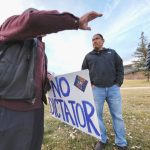
Letters | Producing ‘natural’ uranium for clean nuclear energy
Producing ‘natural’ uranium for clean nuclear energy
Editor,
Dear honorable leaders of the Navajo Nation,
I write this letter, representing myself and the Native American employees who work at Energy Fuels’ White Mesa Mill, where we produce uranium and other critical minerals. We acknowledge the concerns raised by our President Buu Van Nygren and Speaker Crystalyne Curley regarding the transportation of uranium ore through Navajo land and the unease these minerals cause the public.
However, based on our extensive experience and knowledge in this industry, our people truly have nothing to worry about. Energy Fuels takes personal safety and environmental protection/conservation extremely seriously. I can confidently say we take all necessary precautions to ensure the safe transportation and handling of all materials. We consistently meet and, in many cases exceed, all laws, regulations, and protocols. We are concerned about Navajo Attorney General Ethel Branch’s statement implying that our operations are not safe or regulated sufficiently, during a recent “Lunch and Learn” virtual event. This is simply not true.
Compared to the industry’s practices over a half-century ago modern uranium mining and processing is done in a safer, more efficient, and responsible manner. Similarly, the transportation of this ore has improved in safety, containment, and efficiency. Energy Fuels hauled about 300,000 tons of ore in 15,000 loads across the Navajo Nation between about 2007 and 2015 with no spills, accidents, or issues. I’d like to point out that ore is just rocks, it is nonflammable, nonexplosive, nonhazardous, and cannot soak into the ground unlike gasoline/diesel, propane, chemicals, and other hazardous materials that are hauled on roads and rails across the Navajo Nation daily.
I believe it is important to recognize the significance of the work being done here at the White Mesa Mill. We provide valuable clean energy resources for the nation as well as support the local economy. With the current lack of good, local jobs, the Mill is providing Navajo families with close-to-home, fulfilling, long-term employment. All while teaching us skills and knowledge, only a percentage of people globally have the opportunity to learn firsthand.
Here at the Mill, we safely produce uranium for clean nuclear energy, which currently provides about 50% of all carbon-free electricity in the U.S. We also are becoming the nation’s leader in rare earth element separation. These elements are key ingredients in electric and hybrid vehicles, wind energy, smartphones, and other technologies. Moreover, we are studying the recovery of other elements and isotopes found in uranium mines with the potential for groundbreaking medical treatments. These preliminary studies show great promise as a literal cure for cancer.
We urge our Navajo Nation leaders to consider the positive impact Energy Fuels has on our community and the opportunities it provides for us. We respectfully request open dialogue to address any questions or concerns as well as to explore potential solutions. We want solutions that preserve our lands as well as support economic development, career opportunities, and our families.
As proud Native Americans, we recognize the strength in unity and the importance of solidarity during challenging times. We understand the significance of how good jobs empower our community, support our families, enhance our quality of life, and promote us to walk in beauty.
At Energy Fuels, we have found a work environment that supports and prioritizes the well-being and safety of its employees. This company adheres to strict safety protocols and provides ongoing and consistent training to ensure that all employees work safely and securely.
It also needs to be emphasized that the uranium we work with is “natural” uranium. It occurs organically in soil, rock, and water all over the world. This uranium is naturally not very radioactive. Workers here are subject to the same radiation limits as airline pilots, flight attendants, X-ray technicians, and other jobs with this same potential for exposure. Like those jobs, our exposure is carefully monitored. It’s found that here at the Mill we are typically far below those limits. This ensures that members of the public who live and work on the ore haul route will have zero exposure.
Even in the unlikely event of a major Ore truck accident, the cleanup would be routine. The area would be scanned and completely cleaned up within approximately two days. No special protective clothing or equipment is required, except an exposure badge, which is used by all radiation workers to monitor safety.
We collectively take pride in the work we do at Energy Fuels and the positive impact it has on our personal growth, the World, and the broader Navajo community. We respectfully request that you, as Navajo leaders, listen to our scientific knowledge and our experienced perspectives before making critical judgments that can detrimentally affect our families. Energy Fuels plays a critical role in sustaining our livelihoods and fostering a brighter future for all of us. Your support will enable us to continue thriving and contribute positively to our communities.
Thank you for considering our perspective on the safety and security of our jobs at Energy Fuels Inc. We will continue to contribute to the success of both the company and the Navajo Nation.
Talyor Buck and the Native American employees of the White Mesa Mill
Bluff, Utah
Editor’s note: Taylor Buck is the warehouse assistant for Energy Fuels Resources Inc.
NGS, Peabody mine failure on tribe’s part
Editor,
At the Albuquerque Navajo Nation Energy Summit, DOJ’s attorney and the Navajo president’s attorney gave their version of the closure of NGS and Peabody Coal Mine. Let me begin by stating that is not what happened with the closure. It was a failure on the tribe’s part that they closed the operations. I was a contractor employed by the mine and plant during that period. I have since moved my family off the reservation and work in the gas fields.
Here is the real story. The Navajo Nation Council voted and agreed to let Kayenta Mine and Navajo Generating Station close by a Council vote of one, which by the way was a controversial vote in itself. After months of negotiations even President Jonathan Nez refused to weigh in and help the mine and power plant stay open. This is most likely the reason Mr. Nez lost the Navajo Nation elections.
At the center of saving Kayenta Mine and NGS was Navajo Transitional Energy Company. Once NTEC received notification that the mine and plant would be closing they started their due diligence at the request of the tribe. Their technical teams did several site visits to the mine and plant to assess the purchase. They moved quickly and efficiently in getting all the right companies in place to make the purchase. NTEC’s proposal was to buy both the mine and power plant and operate them vertically.
NTEC began by getting a commitment from Peabody Coal Company to continue to be the mine operator under NTEC. In return Peabody committed to have some of their Midwest buyers purchase the NGS power. Next NTEC solicited from three power operators who agreed to operate the SRP Power Plant if they were selected. Next NTEC got the union to agree and operate at a reduction for a short period.
These four things were key to success early on which NTEC secured. The sticky part was getting SRP and its partners to allow NTEC access to the existing transmission lines. SRP first wanted a formal signal from Navajo Nation that the tribe wanted the plant to continue before they committed to the line access. Hence the vote by Council was needed.
This was a business transaction between companies, whom all signed NDA’s. The tribal government was not privy to the details, including DOJ and OPVP because of the NDA’s. Plus, the tribal government had and still has no energy experts. Because of SRP request, all the Navajo Nation leadership had to do was vote and agree to keep the plant and mine open through NTEC. Inside the purchase package NTEC told Navajo Nation they would be paid a minimum of $90 million dollars per year for the life of the operations.
Almost weekly, four Navajos undertook the task to try and convince leadership to support the purchase. Delegate Rickie Nez and Delegate Herman Daniels led that charge from Council. From NTEC’s side it was Gray and Zah. These four Navajos had the responsibility of getting the tribal leadership on board to continue a $400 million dollar economic engine for the Navajo Nation. The NTEC package was finalized, all set and ready to begin once the tribe voted.
The truth is there were many internal forces, such as DOJ and OPVP, working against the deal to not allow it to move forward. The false narrative was rampant on the continuation of the mine and plant.
In the end, the Navajo Nation lost the greatest economic opportunity to become the southwest King of Power by one vote. The idea that a tribe would control the Southwest power market worried many Western Power providers and States. With the closure of the NGS plant the tribe lost their access to 50,000 acre-feet of water. The States made sure that never came back to the Nation. Navajo did get access to two transmission lines for a fee of $2,000,000.00/year, which the tribes must pay each year for 10 years to SRP.
Lastly, 800 Navajo families who worked at the mine and power plant left the region to find work elsewhere, including my family and I. This is Navajos sad story of what happened with the closure of the Kayenta Mine and the Navajo Generating Station plant. Therefore, DOJ and the tribal attorneys should not shed one tear over what happened because they helped the deal fail. This, my people, is the real story of what happened.
Since that time NTEC has made even larger business purchases far away from the Navajo Nation and the sacred mountains. As NTEC and their partners put a hydrogen and sequestration project before the Navajo Nation, the question is, will Navajo turn its back again on another large economic opportunity for our people?
If it does then the tribe will once again have chosen poverty over economic prosperity.
David Slim
Kayenta, Ariz.








 Highway 264,
Highway 264, I-40, WB @ Winslow
I-40, WB @ Winslow